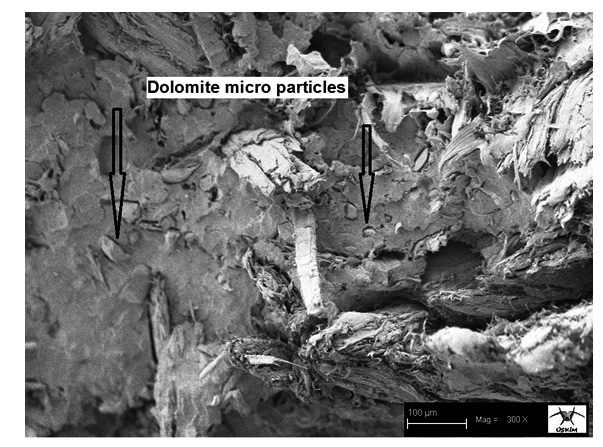EFFECT OF DOLOMITE POWDER ON COMBUSTION AND TECHNOLOGICAL PROPERTIES OF WPC AND NEAT POLYPROPYLENE
- Dolomite powder,
- mechanical properties,
- Combustion,
- wood plastic composite
Copyright (c) 2018 Journal of the Chilean Chemical Society

This work is licensed under a Creative Commons Attribution-NonCommercial-ShareAlike 4.0 International License.
Abstract
Water resistance, mechanical properties, and limiting oxygen index (LOI) of wood plastic composites (WPCs) and neat polypropylene filled with different amounts (3, 6, and 9% by weight) of dolomite powder and wood flour (15 and 30 by weight) were investigated. Wood flour, dolomite powder, polypropylene, and wax were dry-mixed in a high-intensity mixer to produce a homogeneous blend. This blend was then compounded in a laboratory-scale single screw extruder. Test specimens were produced by injection moulding process from the pellets dried to moisture content of 1%. The thickness swelling and water absorption of the dolomite polypropylene composites (DPCs) and WPCs slightly increased with increasing dolomite powder content but the differences were not significant. The flexural modulus and tensile modulus of the WPCs and DPCs increased with increasing dolomite powder content while the flexural strength and tensile strength slightly decreased. The LOI of the WPCs and DPCs increased with increasing dolomite powder content, which extended the times to ignition of WPC and polypropylene. Based on the findings obtained from the present study, it can be said that 6 wt% dolomite powder is the optimum amount in the manufacture of WPC and DPC.

References
- A.K. Bledzki, J. Gassan, Prog. Polym. Sci. 24, 221, (1999).
- A. Kaymakci, N. Ayrilmis, Compos. Part B 58, 582, (2014).
- F. Orellana, J. Lisperguer, C. Nunez, J. Chil. Chem. Soc. 59, 2389, (2014).
- J.G. Gwon, S.Y. Lee, S.J. Chun, G.H. Doh, J.H. Kim, J. Compos. Mater. 46, 301, (2012).
- M. Hetzer, J. Naiki, H. Zhou, T. Poloso, D.D. Kee, J. Compos. Mater. 43, 2285, (2009).
- J.P. Zhou, K.Q. Qiu, W.L. Fu, J. Compos. Mater. 39, 1931, (2005).
- A.O. Adesakin, O.O. Ajayi, P.E. Imosili, B.E. Attahdaniel, S.O.O. Olusunle, Chem. Mater. Res. 3, 36, (2013).
- J. Jancar, E. Fekete, P.R. Hornsby, Mineral fillers in thermoplastics I: raw materials and processing. Springer Science & Business Media, Berlin, Germany, (1999).
- S.N. Bhavsar, H.B. Joshi,, P.K. Shrof, P.J. Ankit, Int. J. Develop Res. 3, 158, (2014).
- Dolomite Analysis Report. Doltas Mineral and Chemical Ltd. Com. Izmir, Turkey, (2009) (Accessed on 23 November 2009). Retrieved from http:// www.doltas.com/mtadolomitanalizraporu.pdf.
- N. Ayrilmis, A. Kaymakci, F. Ozdemir, J. Appl. Polym. Sci. 129, 1170, (2013).
- T. Morii, S. Tomioka, H. Hamada, Sci. Eng. Compos. Mater. 18, 87, (2011).
- N. Ayrilmis, S. Jarusombuti, J. Compos. Mater. 45, 103, (2011).
- A. Ayrilmis, J.T. Benthien, H. Thoemen, R.H. White, J. Appl. Polym. Sci. 122, 3201, (2011).
- N. Ayrilmis, J.T. Benthien, H. Thoemen, R.H. White, Eur. J. Wood Prod. 70, 215, (2012).
- C.H. Kurt, Determination of calcination characteristics of dolomite. MSc Thesis. Institute of Natural and Applied Sciences University of Cukurova, Adana, Turkey, (2010).
- B. Mohebby, H. Younesi, A. Ghotbifar, S. Kazeimi-Najafi, J. Reinf. Plas. Compos. 29, 830, (2010).
- B. Ghada, Z. Rachida, M. Ahmed, D. Faycal, Asian J. Chem. 22, 6687, (2010).
- D. Ndiaye, B. Diop, C. Thiandoume, P.A. Fall, A.K. Farota, A. Tidjani, Morphology and thermo mechanical properties of wood/polypropylene composites. Chapter 22, In F. Dogan (ed.), Polypropylene, InTech Publisher, Rijeka, Crotia, (2012).
- M. Chaharmahali, M. Tajvidi, S.K. Najafi, Polym. Compos. 29, 606, (2008).
- D.F. Caulfield, C. Clemons, R.E. Jacobson, R.M. Rowell, Wood thermoplastic composites, In Rowell, R. M. (Ed.), Handbook of wood chemistry and wood composites. CRC Press, Boca Raton USA, (2005).
- T. Taj, Preparation and characterization of agro-wastes based polymer composites for commercial use. Ph.D. Thesis, University of Punjab, Lahore, Pakistan, (2009).
- O. Martikka, Impact of mineral fillers on the properties of extruded wood-polypropylene composites. Ph.D. Thesis, Lappeenranta University of Technology, Lappeenranta, Finland, (2013).
- X.Y Pang, M.K. Song, Y. Tian, M.W. Duan, J. Chil. Chem. Soc. 57, 1318, (2012).
- B.K. Deka, T.K. Maji, Polym. Bullet. 67, 1875, (2011).
- B.K. Deka, T.K. Maji, Polym. Eng. Sci. 52, 1516, (2012).
- A. El-sabbagh, L. Steuernagel, G. Ziegmann, J. Reinf. Plast. Compos. 22, 1030, (2013).
- M.N.S. Kumar, Siddaramaiah, T.M. Kotresh, I. Shekar, J.H. Jagannath, J. Reinf. Plast. Compos. 28, 537, (2009).
- Z. Wu, N. Hu, Y. Wu, Z. Qin, J. Nanomater. Article ID 945308, 8 p, (2014).
- A.B. Morgan, J.M. Cogen, R.S. Opperman, J.D. Harris, Fire Mater. 31, 387, (2007).
- Stark NM, White RH, Mueller SA, T.A. Osswall, Polym. Degrad. Stabil. 95, 1903, (2010).
- M.K. Kuzman, P. Grošelj, Wood Res. 57, 591, (2012).
- R.H. White, Wood Sci. 12, 113, (1979).
- S.H. Chiu, W.K. Wang, Polym. 39, 1951, (1998).


